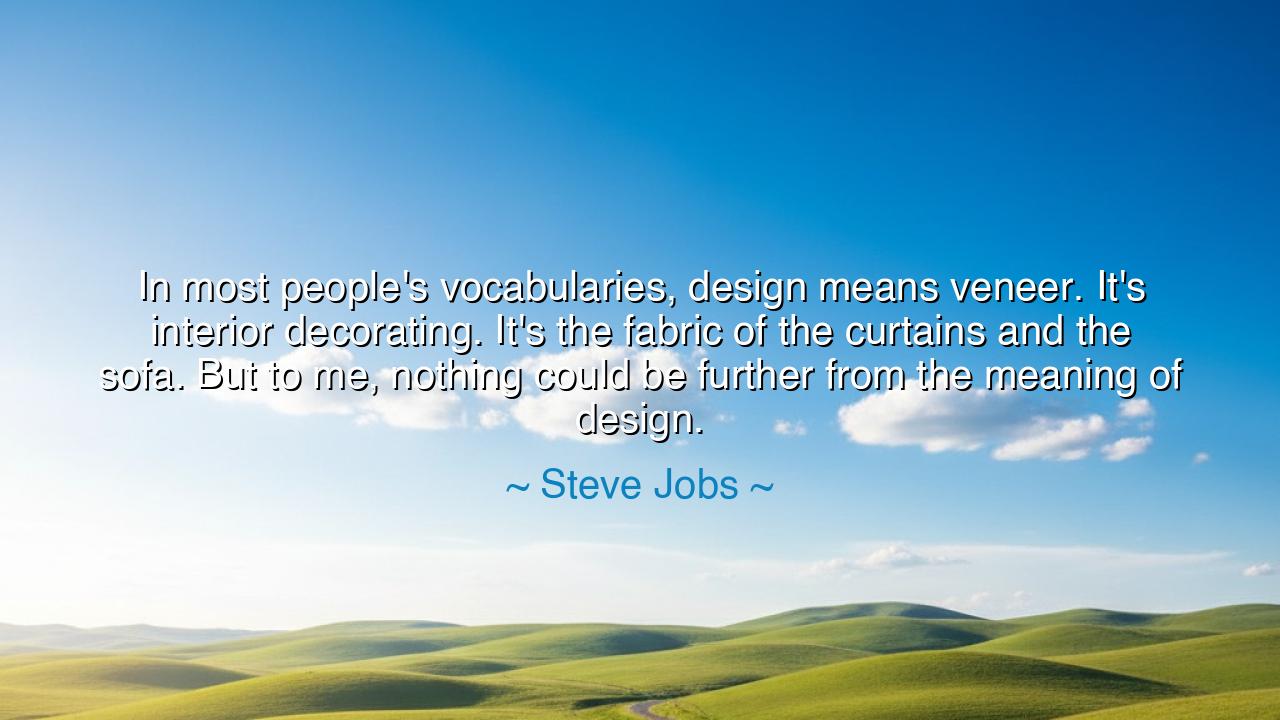
In most people's vocabularies, design means veneer. It's interior
In most people's vocabularies, design means veneer. It's interior decorating. It's the fabric of the curtains and the sofa. But to me, nothing could be further from the meaning of design.






When Steve Jobs declared, “In most people's vocabularies, design means veneer. It's interior decorating. It's the fabric of the curtains and the sofa. But to me, nothing could be further from the meaning of design,” he was not merely speaking as a man of technology, but as a philosopher of creation. His words cut to the heart of a misunderstanding that has haunted every age: the belief that beauty is only skin-deep, that design concerns itself with surface, not soul. Yet Jobs, with the fierce clarity of vision that marked his life, saw what the ancients themselves understood — that true design is not appearance, but essence. It is the joining of form and function, the marriage of spirit and matter, the shaping of the invisible into the visible.
This truth, though spoken in the age of machines, is as old as the craft of humanity itself. The builders of the Parthenon in Athens did not carve its columns for ornament alone; they shaped them with precise proportion so that the structure might stand for millennia. The artisans of ancient Egypt, in gilding the tombs of kings, sought not to decorate but to preserve eternity in form. Likewise, Leonardo da Vinci — painter, inventor, dreamer — believed that every stroke of art was born of knowledge, every machine a poem in motion. Jobs stood in their lineage. His vision was not to make devices that dazzled the eye, but to create tools that felt inevitable, as if nature herself had whispered their design.
When he says that most see design as “veneer,” he mourns a civilization that has forgotten the sacred purpose of creation. In his time, the world was filled with objects made for profit, not for love — objects that looked sleek but broke in the hand, that promised more than they gave. Against this tide of superficiality, Jobs raised a banner of truth: that design is not what something looks like, but how it works. The curve of the iPhone’s edge, the click of its button, the clarity of its screen — all were not decorations, but expressions of purpose. He sought to make machines that did not merely perform, but breathed harmony — devices so simple, so graceful, that they disappeared into the rhythm of human life.
Consider how his philosophy transformed the world. When Jobs and his team at Apple crafted the first Macintosh, they fought not for aesthetics alone, but for the experience — the way a person would feel when touching, seeing, hearing, and using the device. It was an act of empathy, of design as communication. Every element — from the rounded corners to the soft startup sound — spoke of care. And though others mocked him for his obsession with perfection, history proved him right. His creations were not mere machines; they were manifestations of vision, proof that when design serves meaning, beauty follows as naturally as light after dawn.
This is why his words strike with the weight of eternal wisdom: they remind us that true design is integrity made visible. It is the quiet discipline of aligning every detail with the purpose of the whole. Whether one builds a house, writes a story, or lives a life, design demands the same devotion: nothing false, nothing wasted, nothing done for appearance alone. The ancients called this principle arete — excellence of form born from excellence of soul. To design rightly is to live rightly, to let one’s work reflect the order of one’s heart.
But such purity does not come easily. The world tempts the creator with shortcuts — to polish the outside and neglect the inside, to seek praise rather than perfection. Jobs’ words are a warning against this decay. For when form loses its fidelity to purpose, beauty becomes hollow. The curtain may shimmer, but the walls behind it crumble. Thus, he teaches that the artist, the craftsman, the innovator must always begin from the core — from truth, from empathy, from function — and let beauty arise naturally from sincerity. To build without integrity is to create ghosts; to build with it is to touch the eternal.
So let this be your lesson, O reader: Design your life as Jobs designed his creations — from the inside out. Let your actions reflect your purpose, your words match your values, your works embody your ideals. Do not settle for ornament when you can build essence. Whether you are crafting a tool, a home, a relationship, or a destiny, remember that the truest beauty lies not in how it looks, but in how it works — how it serves, how it uplifts, how it endures. For in every age, those who live and create with integrity become, like Jobs, architects of meaning — and their work, no matter how small, becomes a vessel of timeless design.






AAdministratorAdministrator
Welcome, honored guests. Please leave a comment, we will respond soon